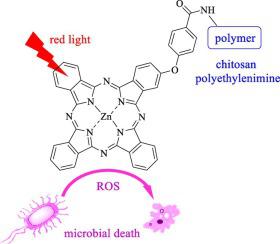当前位置:
X-MOL 学术
›
Eur. Polym. J.
›
论文详情
Our official English website, www.x-mol.net, welcomes your feedback! (Note: you will need to create a separate account there.)
Synthesis, spectroscopic properties and photodynamic activity of Zn(II) phthalocyanine-polymer conjugates as antimicrobial agents
European Polymer Journal ( IF 6 ) Pub Date : 2020-07-01 , DOI: 10.1016/j.eurpolymj.2020.109816 Estefanía Baigorria , María E. Milanesio , Edgardo N. Durantini
European Polymer Journal ( IF 6 ) Pub Date : 2020-07-01 , DOI: 10.1016/j.eurpolymj.2020.109816 Estefanía Baigorria , María E. Milanesio , Edgardo N. Durantini

|
Abstract Conjugates of Zn(II) phthalocyanine to chitosan (CS) and polyethylenimine (PEI) were synthetized through the following stages: first a phthalonitrile substituted by a (carbomethoxy)phenoxy group (Pn 1) was obtained by nucleophilic aromatic substitution reaction, then a AB3 Zn(II) phthalocyanines (ZnPc 2) was synthesized by the ring expansion reaction of boron(III) subphthalocyanine (SubPc) chloride with Pn 1. After hydrolysis of ZnPc 2, a Zn(II) phthalocyanine bearing a carboxylic acid group (ZnPc 3) was obtained, which was conjugated to CS (CH-ZnPc 4) and PEI (PEI-ZnPc 5) by amide bond. UV–visible absorption and fluorescence spectra presented the characteristic bands of the Zn(II) phthalocyanine in N,N-dimethylformamide (DMF), with appropriate fluorescence quantum yield. Also, the conjugation of Zn(II) phthalocyanine to polymers was confirmed by IR spectra. These conjugates were able to photosensitize singlet molecular oxygen in DMF and aqueous medium. Moreover, they induced the formation of superoxide anion radical in the presence of NADH. The results showed that type II pathway is involved in the photodecomposition of Trp sensitized by these conjugates, although there is also a contribution from the type I mechanism. Photoinactivation of microorganisms was investigated in Candida albicans, Staphylococcus aureus and Escherichia coli and, varying the concentration of CH-ZnPc 4 and PEI-ZnPc 5 and the irradiation times. Both conjugates were efficient in the eradication of S. aureus by PDI, while that PEI-ZnPc 5 was the most effective for photokilling C. albicans. These conjugates were little active to photoinactivation of E. coli. However, the addition of CS allowed to improve the photocytotoxicity towards this Gram-negative bacterium. These results indicate that PEI-ZnPc 5 is an efficient photosensitizer to inactivate S. aureus and C. albicans. In addition, it is capable of killing E. coli cells in the presence of CS.
中文翻译:

Zn(II) 酞菁-聚合物偶联物作为抗菌剂的合成、光谱特性和光动力学活性
摘要 Zn(II) 酞菁与壳聚糖 (CS) 和聚乙烯亚胺 (PEI) 的共轭物通过以下阶段合成:首先通过亲核芳香取代反应获得被(碳甲氧基)苯氧基(Pn 1)取代的邻苯二甲腈,然后是AB3 Zn(II) 酞菁 (ZnPc 2) 是通过硼 (III) 亚酞菁 (SubPc) 氯化物与 Pn 1 的扩环反应合成的。 ZnPc 2 水解后,带有羧酸基团的 Zn(II) 酞菁 (ZnPc) 3) 得到,其通过酰胺键与 CS (CH-ZnPc 4) 和 PEI (PEI-ZnPc 5) 共轭。紫外-可见吸收和荧光光谱呈现了 N,N-二甲基甲酰胺 (DMF) 中 Zn(II) 酞菁的特征带,具有适当的荧光量子产率。还,红外光谱证实了 Zn(II) 酞菁与聚合物的共轭。这些缀合物能够使 DMF 和水性介质中的单线态分子氧光敏化。此外,它们在 NADH 存在下诱导超氧阴离子自由基的形成。结果表明,II 型途径参与了这些偶联物致敏的 Trp 的光分解,尽管 I 型机制也有贡献。在白色念珠菌、金黄色葡萄球菌和大肠杆菌中研究了微生物的光灭活,并改变了 CH-ZnPc 4 和 PEI-ZnPc 5 的浓度以及照射时间。两种偶联物均能有效地通过 PDI 根除金黄色葡萄球菌,而 PEI-ZnPc 5 对光杀白色念珠菌最有效。这些缀合物对大肠杆菌的光灭活几乎没有活性。然而,添加 CS 可以提高对这种革兰氏阴性细菌的光细胞毒性。这些结果表明PEI-ZnPc 5 是灭活金黄色葡萄球菌和白色念珠菌的有效光敏剂。此外,它能够在 CS 存在下杀死大肠杆菌细胞。
更新日期:2020-07-01
中文翻译:

Zn(II) 酞菁-聚合物偶联物作为抗菌剂的合成、光谱特性和光动力学活性
摘要 Zn(II) 酞菁与壳聚糖 (CS) 和聚乙烯亚胺 (PEI) 的共轭物通过以下阶段合成:首先通过亲核芳香取代反应获得被(碳甲氧基)苯氧基(Pn 1)取代的邻苯二甲腈,然后是AB3 Zn(II) 酞菁 (ZnPc 2) 是通过硼 (III) 亚酞菁 (SubPc) 氯化物与 Pn 1 的扩环反应合成的。 ZnPc 2 水解后,带有羧酸基团的 Zn(II) 酞菁 (ZnPc) 3) 得到,其通过酰胺键与 CS (CH-ZnPc 4) 和 PEI (PEI-ZnPc 5) 共轭。紫外-可见吸收和荧光光谱呈现了 N,N-二甲基甲酰胺 (DMF) 中 Zn(II) 酞菁的特征带,具有适当的荧光量子产率。还,红外光谱证实了 Zn(II) 酞菁与聚合物的共轭。这些缀合物能够使 DMF 和水性介质中的单线态分子氧光敏化。此外,它们在 NADH 存在下诱导超氧阴离子自由基的形成。结果表明,II 型途径参与了这些偶联物致敏的 Trp 的光分解,尽管 I 型机制也有贡献。在白色念珠菌、金黄色葡萄球菌和大肠杆菌中研究了微生物的光灭活,并改变了 CH-ZnPc 4 和 PEI-ZnPc 5 的浓度以及照射时间。两种偶联物均能有效地通过 PDI 根除金黄色葡萄球菌,而 PEI-ZnPc 5 对光杀白色念珠菌最有效。这些缀合物对大肠杆菌的光灭活几乎没有活性。然而,添加 CS 可以提高对这种革兰氏阴性细菌的光细胞毒性。这些结果表明PEI-ZnPc 5 是灭活金黄色葡萄球菌和白色念珠菌的有效光敏剂。此外,它能够在 CS 存在下杀死大肠杆菌细胞。



























 京公网安备 11010802027423号
京公网安备 11010802027423号